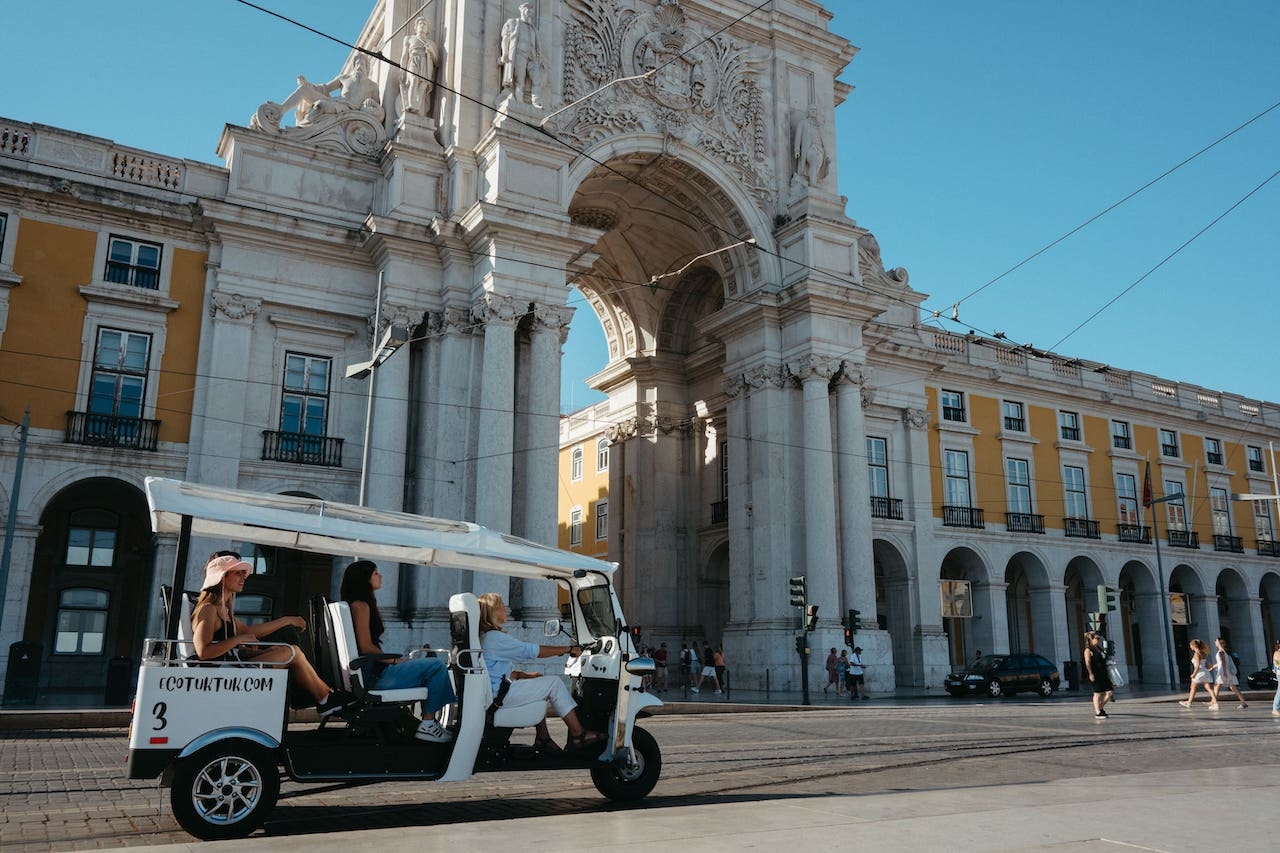10 Best Day Trips from Lisbon

Lisbon is a dynamic city full of culture, but one of its greatest advantages is its location. In less than two hours, you can escape the city and discover enchanting palaces, golden beaches, ancient monasteries and picturesque villages. The surrounding region offers a perfect mix of history, nature and adventure. Whether you’re a history buff, nature lover or beachgoer, these day trips provide a deeper look into Portugal’s diverse beauty.
Top best day trips from Lisbon (Portugal)
Lisbon’s strategic location makes it a perfect base for discovering the diverse beauty of central Portugal. From the enchanting palaces of Sintra to the coastal charm of Cascais, each destination offers its own unique appeal. Whether you prefer exploring historic landmarks, soaking up the sun on golden beaches, or immersing yourself in local culture, these day trips are sure to enrich your travel experience.
-
Sintra
Sintra, a UNESCO World Heritage Site, is one of the best day tours from Lisbon you can take. Tucked away in lush, misty hills, Sintra boasts a collection of vibrant palaces, mysterious estates and ancient fortresses. Its romantic and whimsical architecture draws visitors year-round. Kings and aristocrats once used Sintra as their summer retreat, leaving behind stunning palaces and mansions.
How to get there:
- By train: Depart from Rossio Station (40 minutes, €5 round trip).
- By car: 30-40 minutes via IC19, but parking is limited.
- Tour options: Numerous guided tours combine Sintra with Cabo da Roca or Cascais.
What to do:
Pena Palace: This brightly colored Romanticist palace sits atop Sintra’s highest peak and offers panoramic views of the surrounding forest and coastline.
Quinta da Regaleira: Known for its underground tunnels, grottos, and the mystical Initiation Well, it’s a must-visit for anyone intrigued by symbolism and secret gardens.
Moorish Castle: These ancient ruins provide breathtaking views and a chance to walk along the fortress walls.
Palácio Nacional de Sintra: Located in the town center, this palace features iconic twin chimneys and beautiful tilework.
Monserrate Palace: Often overlooked, this palace blends Gothic, Moorish, and Indian influences and is surrounded by exotic gardens.
Pro tip:
Arrive early to beat the crowds. Sintra is one of the most visited spots in Portugal, especially in summer.
-
Cascais
Cascais is a sophisticated coastal town that combines the charm of a traditional fishing village with the elegance of a modern resort destination. Cascais became a favorite retreat for the Portuguese royal family in the late 19th century, transforming it into a fashionable beachside escape. Today, it remains popular for its golden beaches, charming marina, and thriving food scene.
How to get there:
- By train: Direct trains from Cais do Sodré Station (40 minutes, €3 each way).
- By car: 30 minutes via A5.
What to do:
Boca do Inferno: Watch waves crash into this dramatic cliff formation, creating natural blowholes. It’s especially stunning at sunset.
Cascais Marina: A lively spot with seafood restaurants and waterfront bars.
Guincho Beach: Known for strong winds and excellent surfing, it’s also great for beach walks.
Cidadela de Cascais: A fortress turned into a luxury hotel and art district.
Paula Rego Museum: Dedicated to one of Portugal’s most renowned artists, showcasing modern Portuguese art.
Local flavor:
Sample fresh grilled fish at Mar do Inferno or try Cascais’ famous amêijoas à Bulhão Pato (garlic clams).
-
Ericeira
Ericeira is a laid-back fishing town that has gained international fame as a World Surfing Reserve. Known for its dramatic cliffs, sandy beaches, and excellent seafood, Ericeira offers a mix of surf culture and traditional Portuguese life. Its relaxed vibe and oceanfront promenade make it perfect for a peaceful escape from Lisbon.
How to get there:
- By car: 50 minutes via A8 and A21.
- By bus: Mafrense buses from Campo Grande (75 minutes).
What to do:
Ribeira d’Ilhas Beach: One of the best surf beaches in Europe, known for world-class waves.
Old Town: Stroll through narrow streets lined with whitewashed houses and blue trim.
Praia dos Pescadores: A sheltered beach ideal for swimming and sunbathing.
Seafood Dining: Visit one of the many seafood taverns for fresh prawns, octopus, and clams.
Pro tip:
Stop by nearby Mafra National Palace, one of Portugal’s largest baroque palaces.
-
Óbidos
Óbidos is one of Portugal’s best-preserved medieval towns, known for its cobbled streets, ancient city walls, and striking castle. Originally a Moorish stronghold, Óbidos was gifted to Portuguese queens as a wedding present, earning it the nickname “The Queen’s Town”.
How to get there:
- By car: 1 hour via A8.
- By bus: From Sete Rios (around 90 minutes).
What to do:
Óbidos Castle: Climb the walls and explore this iconic fortress.
Rua Direita: The town’s main street is packed with artisan shops and cafes.
Ginja de Óbidos: Don’t leave without trying this cherry liqueur served in chocolate cups.
Literary Paradise: Óbidos is famous for its bookshops in churches and unique literary festivals.
When to visit:
Visit in July for the Medieval Fair or in winter for the Christmas Village.
-
Azenhas do Mar
Azenhas do Mar is a small coastal village carved into cliffs overlooking the Atlantic. Known for its whitewashed houses and dramatic seascapes, it’s a picturesque hidden gem along the Sintra coast.
How to get there:
- By car: 50 minutes via A16.
- By bus: From Sintra (Scotturb buses).
What to do:
Seawater Pool: Swim in the natural pool at the cliff’s base.
Dining: Enjoy fresh seafood at Azenhas do Mar Restaurant with panoramic views.
Photography: Sunset is the best time to visit, with golden light illuminating the cliffs.
-
Peniche & Berlengas Islands
Peniche is a rugged coastal town famous for its fishing industry and dramatic cliffs, but it’s best known as a world-class surf destination. Just offshore, the Berlengas Islands – a UNESCO Biosphere Reserve – offer pristine beaches, sea caves, and rich marine life. Peniche’s mix of adventure, natural beauty, and history makes it a top choice for thrill-seekers and nature lovers alike.
How to get there:
- By car: 1 hour 20 minutes via A8.
- By bus: Rede Expressos buses from Sete Rios (about 1 hour 30 minutes).
- To Berlengas Islands: Ferries depart from Peniche Marina (30-45 minutes). Ferries run daily from May to September, with limited service in the off-season.
What to do:
Supertubos Beach: Famous for massive, tubular waves, this beach hosts international surf competitions, including the World Surf League Championship. Even if you don’t surf, watching the pros in action is exhilarating.
Fort of Peniche: A historic 16th-century fortress that once served as a prison during Portugal’s dictatorship. It now houses a museum dedicated to the history of political resistance.
Praia Baleal: A more beginner-friendly surf spot with golden sands and relaxed vibes.
Exploring Berlengas Islands:
Berlenga Grande: The largest island, home to the Fort of São João Baptista, a striking fortress built into the rocky landscape.
Kayaking and Snorkeling: Explore sea caves and crystal-clear waters around the islands, offering glimpses of underwater wildlife.
Hiking Trails: There are several trails around the island with incredible coastal views and birdwatching opportunities.
-
Nazaré
Nazaré has become famous worldwide for its record-breaking waves that attract surfers chasing the biggest swells on the planet. However, this fishing town has much more to offer – from its rich maritime traditions to its vibrant culture and religious heritage. Nazaré provides a unique blend of extreme sports, stunning coastal scenery, and authentic Portuguese charm.
How to get there:
- By car: 1.5 hours via A8.
- By bus: Rede Expressos from Sete Rios (about 2 hours).
What to do:
Praia do Norte: Home to the legendary giant waves. Visit the Nazaré Lighthouse (Farol da Nazaré), which doubles as a surfing museum showcasing records set by famous surfers like Garrett McNamara.
Sítio da Nazaré: Ride the funicular up to this clifftop area for breathtaking views of the coast and the town below.
Sanctuary of Our Lady of Nazaré: A sacred pilgrimage site believed to have miraculous origins, adding a layer of spiritual depth to your visit.
Fish Market: Experience the vibrant local culture at the bustling Mercado Municipal, where fresh fish and seafood are sold daily.
Hidden gem:
Visit in winter (October to March) to witness the giant wave season. In summer, Nazaré transforms into a peaceful beach town ideal for swimming and sunbathing.
-
Aveiro
Aveiro is a charming coastal city known for its canals, moliceiro boats (colorful gondola-like vessels), and Art Nouveau architecture. Nicknamed the “Venice of Portugal”, Aveiro’s unique landscape is shaped by its lagoon, salt pans, and sandy beaches. Beyond its picturesque scenery, Aveiro offers a vibrant cultural scene and rich maritime heritage.
How to get there:
- By train: 2.5 hours from Santa Apolónia.
- By car: 2.5 hours via A8 and A17.
What to do:
Moliceiro Boat Tours: Cruise along the canals on a traditional moliceiro, once used for seaweed harvesting but now beautifully decorated and used for sightseeing.
Costa Nova: This nearby beach town is famous for its colorful, striped houses (palheiros) that line the coast.
Aveiro Cathedral: A beautiful 15th-century cathedral with impressive azulejo tilework and baroque design.
Museu de Aveiro: Housed in a former convent, the museum tells the story of the city and its patron saint, Princess Saint Joana of Portugal.
Salt Pans: Visit the Salinas de Aveiro to see traditional salt production, a practice that dates back centuries.
-
Setúbal
Setúbal, just south of Lisbon, is a thriving port city known for its seafood, nature reserves, and proximity to the stunning Arrábida Mountains. The town also serves as the gateway to the idyllic Tróia Peninsula, known for its sandy beaches and luxury resorts. Setúbal’s mix of urban life, nature, and maritime heritage makes it an ideal destination for a relaxing day trip.
How to get there:
- By car: 45 minutes via A2.
- By train: Trains from Sete Rios (about 1 hour).
What to do:
Arrábida Natural Park: Hike or drive through this mountain range, home to hidden beaches, forests, and breathtaking coastal views. Portinho da Arrábida Beach is particularly famous for its turquoise waters.
Mercado do Livramento: One of Portugal’s best seafood markets, filled with vibrant displays of fish, fruits, and vegetables.
Ferry to Tróia: Take a short ferry ride to the Tróia Peninsula, known for its long, white-sand beaches and ancient Roman ruins.
Dolphin Watching: Embark on a boat tour to see dolphins in the Sado Estuary.
-
Fátima
Fátima is one of the most important pilgrimage sites in Europe, drawing millions of visitors each year. Known for the apparitions of the Virgin Mary that appeared to three shepherd children in 1917, Fátima is a place of deep faith, reflection, and awe-inspiring architecture. Even non-religious visitors are captivated by the peaceful atmosphere and the site’s historical significance.
How to get there:
- By car: 1.5 hours via A1.
- By bus: Direct Rede Expressos buses from Sete Rios (about 1.5 hours).
What to do:
Sanctuary of Fátima: Visit the vast square and basilicas, including the Basilica of Our Lady of the Rosary and the Chapel of the Apparitions.
Basilica of the Holy Trinity: A modern architectural masterpiece that contrasts with the older religious buildings.
Via Sacra: Walk the path that replicates the Stations of the Cross, leading to the small Chapel of Calvary.
Tip:
Visit during May 13 or October 13 to experience the grand pilgrimage celebrations.
If you want to explore the surroundings of the city in a unique and eco-friendly way, consider taking a tuk tuk tour in Lisbon. These electric tuk tuks offer a fun and efficient way to visit several landmarks while enjoying an open-air ride through picturesque streets and stunning landscapes.
